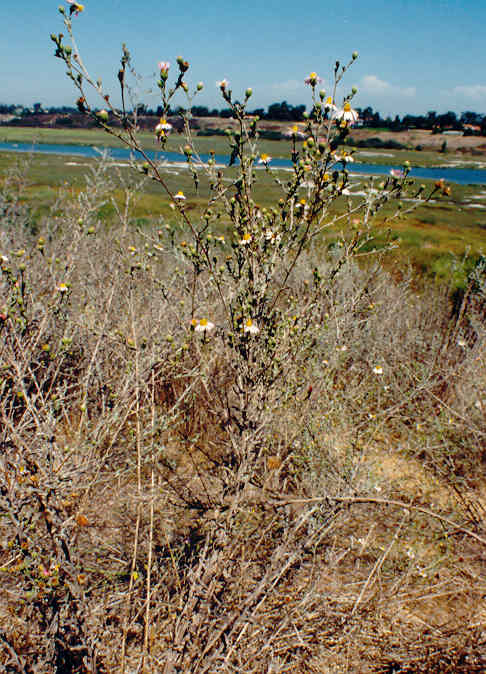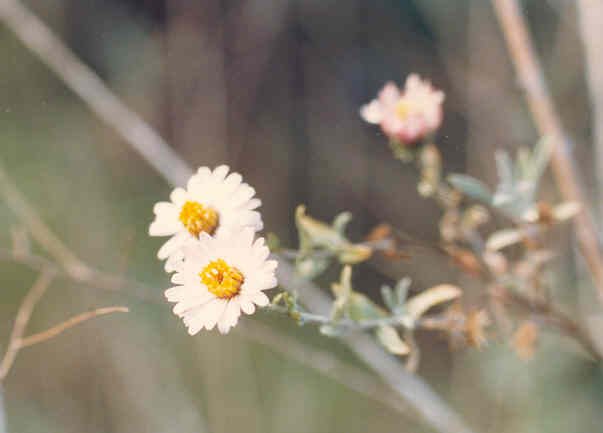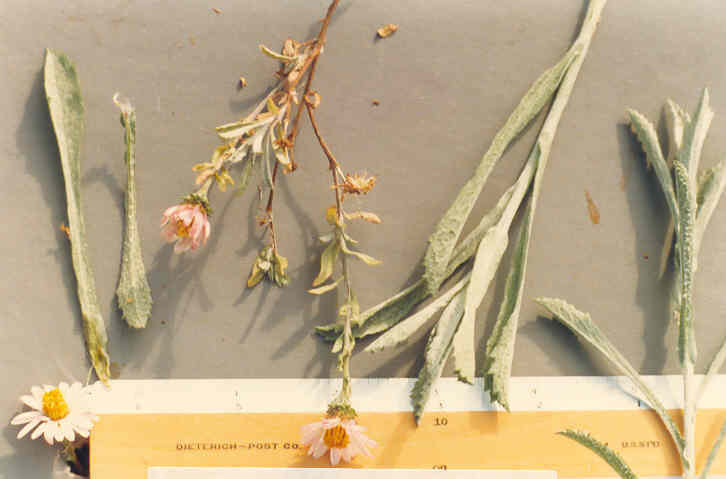
Corethrogyne filaginifolia var. latifolia Hall.
=Lessingia filaginifolia var. filaginifolia
Asteraceae
Sunflower Family
Native
California Aster
Tomentose Cudweed Aster
|
|
Corethrogyne filaginifolia var. latifolia Hall.=Lessingia filaginifolia var. filaginifoliaAsteraceaeSunflower FamilyNative
California AsterTomentose Cudweed Aster
|
September Photo
Plant Characteristics:
Perennial subshrub, suffrutescent, stout, 3-6 dm. high, tomentose
throughout including the invols.; principal lvs. broadly oblong, 1-4 cm. long,
5-12 mm. wide; heads few; invols. 7-8 mm. long, ca. 5-seriate; phyllaries with
slightly spreading tips; rays fls. showy, 10 mm. long, purple, pink or white;
disk, fls. 12-40, corollas, 4-6 mm., tubular, yellow; fr. less than 5 mm.;
pappus 3-8 mm., bristles free, red-brown.
Habitat:
Slopes overlooking the coast; Coastal Sage Scrub; Redondo, Los Angeles
Co. to Santa Barbara Co.; Anacapa Id. Below
2600 m. Aug.-Dec.
Name:
See C. filaginifolia var. virgata
on the genus and first part of the species name.
Latin, latus, broad, wide.
(Jaeger 137). Probably
referring to the broadly oblong lvs. Lessingia, in honor of C.F. Lessing, 1809-1862, German specialist in
Asteraceae.
(Hickman, Ed. 304).
General:
Common in three populations known in the study area.
The largest population is on the Eastbluff bench and is an equal mixture
of var. latifolia and var. virgata. A
small population just below the intersection of Back Bay Dr. and Eastbluff
Dr.
appears to be all var. latifolia. The
third population is in Santa Ana Heights and seems to be an equal mixture of
var. latifolia and var. virgata. (my comments). Three species in the genus.
(Munz, Flora So. Calif. 151).
Variety latifolia is now
included in Lessingia filaginifolia var.
filaginifolia. (Hickman Ed. 305).
Fred Roberts in his second edition of a Checklist
of the Vascular Plants of Orange County, California
1998, states that “while Lessingia
may indeed be a better place for this species, Lane (Novon2:213-214, 1992) does
not adequately address traditional subtaxa in southern California, several of
which are rare, thus I continue to follow Munz (1974).”
Roberts has continued to list this plant as Corethrogyne
and I will modify my list to follow him.
(my comment).
Text Ref:
Abrams, Vol. IV 341; Hickman, Ed. 305, 1327; Munz, Flora
So. Calif. 152; Abrams Vol. IV
341; Roberts 10.
Photo Ref:
Feb. 3 84 # 21,22,E; Sept 95 # 24.
Identity:
by R. De Ruff,
confirmed by F. Roberts.
First Found: March 1984.
Computer Ref: Plant Data 308.
Plant sample donated to U.C. Riverside in 2004.
Last edit. 11/28/03.
 |
 |
February Photo February Photo